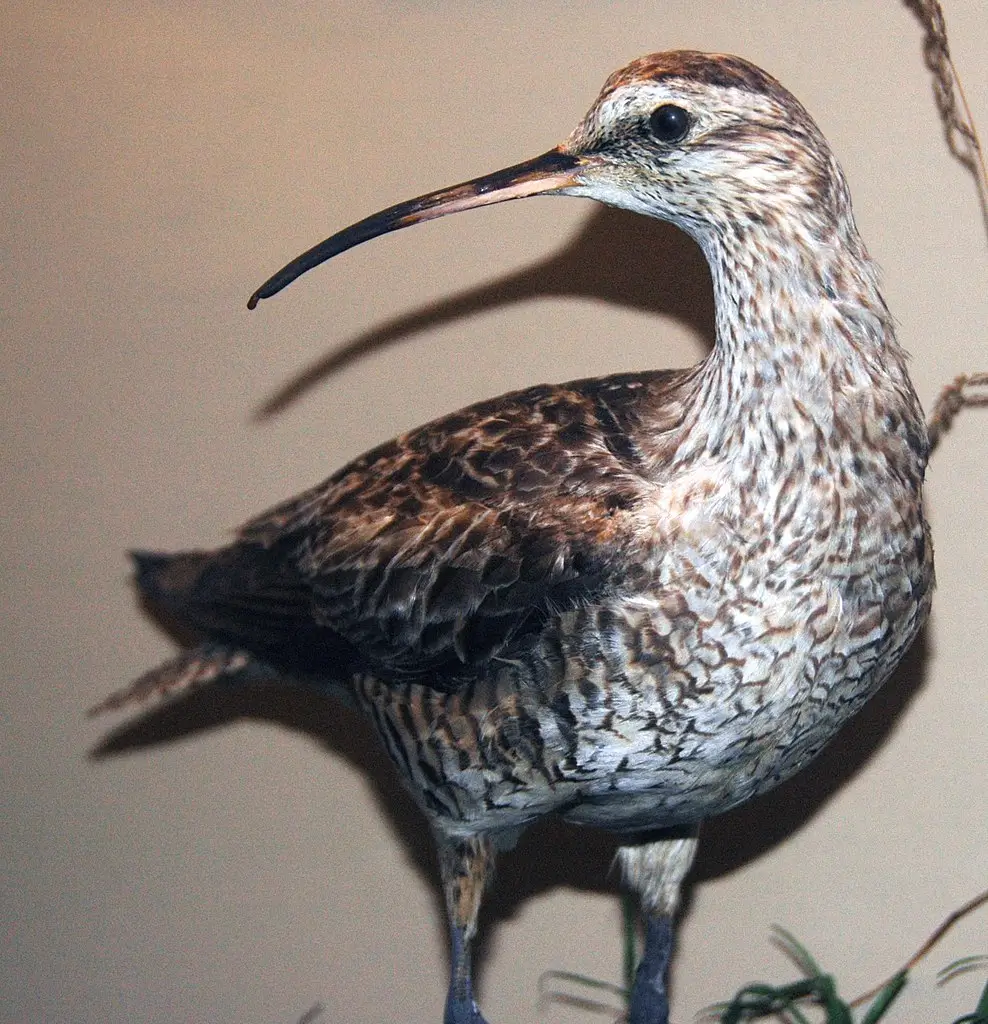Eskimo Curlew
Numenius borealis
Charadriiformes - Scolopacidae - Numenius
The Eskimo Curlew, a shorebird native to the extreme northern regions of North America, migrates to the southernmost parts of South America for the winter. It is one of nine species in the genus Numenius and is currently the most endangered1, with strong suspicions that it may already be extinct.
The Eskimo Curlew resembles other curlews in appearance, with mottled, linen-like brown plumage and a long, down-curved bill. Compared to other curlews, the Eskimo Curlew is smaller (about 30 cm in length, whereas the Whimbrel, another North American curlew, is about 37-47 cm long), has darker legs and feet, a slightly shorter bill, and smooth, unstriped feathers on the underside of the primary wing feathers2.
The Eskimo Curlew is a long-distance migratory bird, with a migration route spanning from the northernmost to the southernmost parts of the Americas. In the fall, they depart from the tundra in the Northwest Territories of Canada and Alaska, migrate eastward to Newfoundland, and then follow the North American east coast to South America, primarily wintering in the pampas of Argentina. In the spring, they cross the Gulf of Mexico and traverse the Great Plains to return to their breeding grounds in the far north3. During migration, the Eskimo Curlew feeds mainly on insects and other invertebrates found along shorelines and fields, as well as berries and other plant matter.
Before the mid-19th century, the Eskimo Curlew population was estimated to be over a million4. However, over the following decades, extensive hunting by humans led to a dramatic population decline, pushing the species towards extinction5. The bird’s restricted habitat and the limited stopover sites along its extensive migration route, which have been lost, fragmented, and degraded due to agricultural development, exacerbated this decline6. By the early 20th century, the Eskimo Curlew had become extremely rare, with the last confirmed records dating from the 1960s. In April 1962, a confirmed photograph of an Eskimo Curlew was taken near Galveston, Texas, close to the Gulf of Mexico. In 1963, a solitary bird was shot near Foster’s Swamp in Barbados7. Since then, there have been several seemingly credible but unverified sightings. One of the more exciting reports was on May 7, 1981, when as many as 23 Eskimo Curlews were sighted near Galveston, Texas8. Sightings continued until 2006, but none have been confirmed, and they have faced corresponding skepticism9.

Here is a high-resolution photograph of another specimen from this museum
-
The Slender-billed Curlew (Numenius tenuirostris) of Europe also has no known populations. However, as of March 2024, the IUCN still lists the Slender-billed Curlew as “Critically Endangered,” while the Eskimo Curlew is listed as “Critically Endangered, Possibly Extinct.” ↩︎
-
Townsend CW. 1933. Sight Records of the Eskimo Curlew. The Auk. 50(2):214–214. doi:https://doi.org/10.2307/4076883. ↩︎
-
Gollop J B, Barry T W, Iversen E H. Eskimo Curlew: A vanishing species? , Saskatchewan Natural History Society Special Publication No. 17. Regina, Saskatchewan. Northern Prairie Wildlife Research Center Online. 1986. ↩︎
-
Estimates of millions exist, but some suggest this is an exaggeration. A more reasonable estimate is in the hundreds of thousands. See: Canadian Wildlife Service. COSEWIC assessment and status report on the Eskimo Curlew, Numenius borealis, in Canada. Ottawa - Ontario : Environment Canada, 2009. ↩︎
-
After the Passenger Pigeon sharply declined around 1880, the Eskimo Curlew, due to its gregarious and predictable behavior, became a substitute target for professional hunters. They were extensively hunted and shipped to the eastern United States to meet the meat demand. See: Edward Howe Forbush. 1912. A history of the game birds, wild-fowl and shore birds of Massachusetts and adjacent states… with observations on their…recent decrease in numbers; also the means for conserving those still in existence, by Edward Howe Forbush, state ornithologist of Massachusetts. Illustrated with drawings by W.I.Beecroft and the author, and photographs by Herbert K. Job and others. Issued by the Massachusetts State board of agriculture. p427. ↩︎
-
Environment Canada. 2007. Recovery Strategy for the Eskimo Curlew (Numenius borealis) in Canada . Species at Risk Act Recovery Strategy Series. Environment Canada, Ottawa. ↩︎
-
This Eskimo Curlew was mingling with other shorebird populations. “At sunset, September 4,1963, a lone Eskimo curlew, flying at the head of a flock of shore birds, was shot down by a hunter on the coast of Barbados….”. See: Bond M W. Did a Barbados hunter shoot the last Eskimo Curlew. Audubon Magazine, 1965, 67: 314-316. Cited from: (Gollop 1986). Cited from: Buckley PA. The Birds of Barbados. BOC Checklists (formerly BOU Checklists). British Ornithologists’ Union. Volume:24. 2009. ↩︎
-
Blankenship D R, King K A. A probable sighting of 23 Eskimo Curlews in Texas. American Birds, 1984, 38(6): 1066-1067. ↩︎
-
See the statistics in (Canadian Wildlife Service, 2009). (Gollop 1986) provides detailed accounts of sightings up to 1986. ↩︎